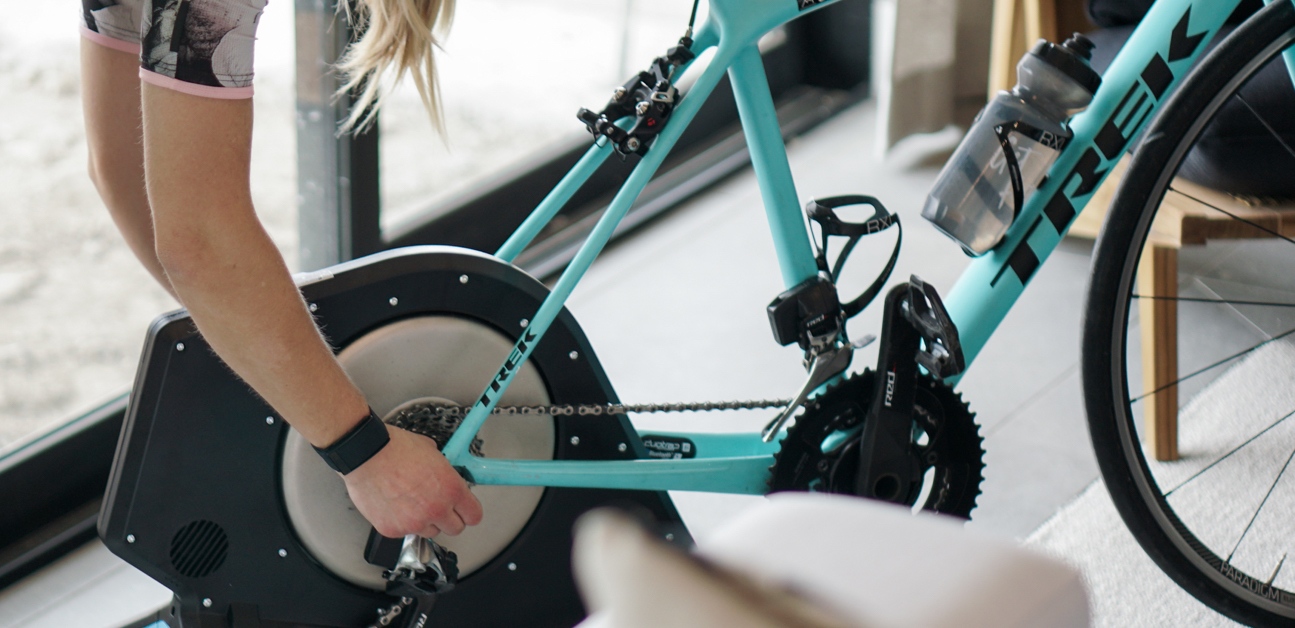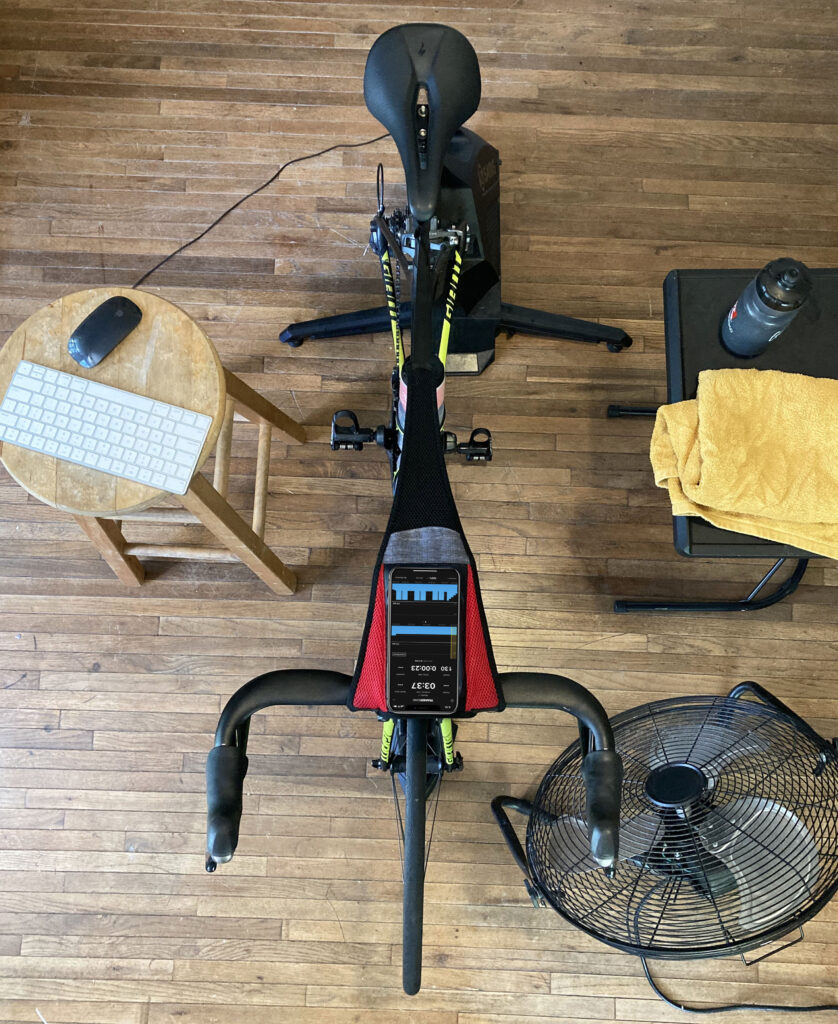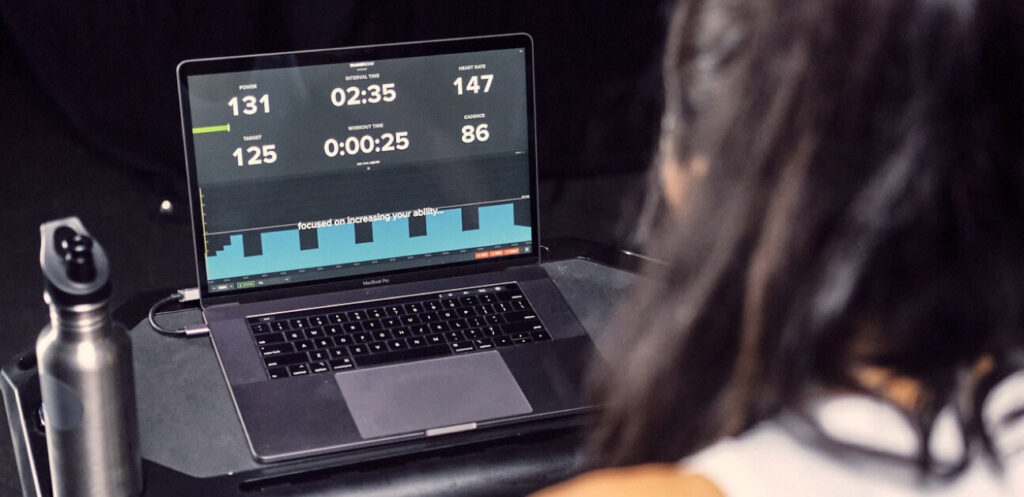Indoor Training Advice For Beginners

Indoor training is amazingly productive and efficient. It can also be intimidating, and many riders avoid it as a result. Luckily, it doesn’t have to be this way. With some easy tips from experience, your indoor workouts can be more comfortable, effective, and enjoyable.
Key Takeaways:
- A good fan is the most important way to improve your indoor workouts
- Good hydration is crucial
- Keep items like towels and your phone handy and easily reachable
- Keep your bike as sweat-free as possible
- Have good entertainment and an easy way to control it
- Prepare for your next ride by filling bottles and readying your clothes in advance
- Take a Ramp Test to make sure your workouts are appropriately intense
It’s All About Cooling
The single most important piece of advice for successful indoor training is to use a powerful fan for every workout. We recommend this fan as our favorite combination of power and value, but any fan is better than nothing. Simply put, cooling is the most important factor influencing your comfort when riding indoors. A whopping 75% of your body’s energy expenditure is emitted as heat, and even during easy rides this can quickly become a limiting factor. Set your fan on the floor or on a table very close to you and angled up at your torso. If you have multiple fans, even better- place them all around you. If your room is air conditioned, turn the AC on, too. It might seem like overkill, when I feel chilly for the first few minutes of my warmup, I consider it a good sign.
Hydration goes hand-in-hand with cooling, and you should plan to drink even more than you do when riding outside. Add ice cubes to your bottles for maximum refreshment, and remember to replace the electrolytes lost in your sweat. Even with good cooling your room can become a sauna during a hard workout, so open the door to let out the humidity your body expels through sweat and exhalation.
Anything that covers your skin can reduce evaporation and trap heat. There’s no good reason to wear a jersey on the trainer, and cotton t-shirts are even worse. The best option is a light summer base layer or simply training shirtless; I even pull down my bib straps and tuck them into the back of my shorts to expose more skin.
Adaptive Training
Get the right workout, every time with training that adapts to you.
Check Out TrainerRoadMaximize Your Training Space
It’s helpful to keep a few important items nearby where you can reach them during your workout. Most importantly, keep a towel handy in a convenient place. A small table or even a chair next to you to drape the towel over is an easy option. This table can also double as a surface on which you can keep food, your phone, and any other items you might need during your ride. Make sure this table is located where you can easily access it, even when your mental bandwidth is reduced during the most intense part of a workout. It’s extremely frustrating (and common) to drop your towel during an interval, so consider keeping a second nearby as backup.
While this towel will mostly be used to dry yourself and keep sweat out of your eyes, don’t forget about keeping your bike dry. Sweat can destroy bearings and bolts quickly, so either drape a towel over your bike or invest in an inexpensive sweat guard (I have this one). If your floor is carpeted, you’ll definitely also want a floor mat below you to catch sweat (and tire fragments, if you’re using a wheel-on trainer).
Have your entertainment ready with a convenient way to control it. Many riders like to watch movies or races while training, but a living room TV is usually mounted too high on the wall to be comfortably viewed from the bike. One good alternative is an Ipad on an adjustable table a bit lower in front of you. I watch movies on my laptop’s external monitor, and I use a wireless mouse and keyboard on the table next to me to control it. This allows me to pause, rewind, or change what I’m watching mid-workout without getting off the trainer or dripping sweat on my computer.
You’ll probably need to turn up your music or TV quite loud to hear them over the sound of your fans. Noise-cancelling headphones are a luxury, but they do an amazing job of drowning out fan noise without waking up the neighbors. AirPod Pros work well for me, but many less-expensive options exist too, just make sure they’re sweat-resistant. Bluetooth is preferable as a headphone wire can get very annoying during a hard workout.

Make It as Convenient as Possible
One big advantage of indoor training is efficiency. Prepare for your ride in advance by having everything ready to go so you can maximize your use of time. If possible, keep your fan in place and leave your bike on the trainer. Each time you finish a ride, immediately wipe your bike down, refill and refrigerate your bottles, and place your shoes and a fresh towel next to the trainer where they will be ready next time.
Keep other supplies such as clean kit, chamois cream, and nutrition products nearby in a convenient place, too. This way you can quickly get dressed, grab bottles from the fridge, and get rolling. It only adds a few minutes to the end of your ride, but a few minutes saved before your next workout removes an easy excuse not to train.
Riding indoors is challenging enough. Take a Ramp Test before your first workout so your training is calibrated to your ability. Other common sources of discomfort include saddle pain and muscular soreness from the static position. To remedy these, wear good-quality cycling shorts (and consider using chamois cream) and never feel bad about taking a quick break to stretch between intervals. Counterintuitively, easy indoor rides often cause more saddle pain than harder workouts, so you should stand and stretch frequently even on recovery spins. Finally, don’t neglect nutrition. Indoor workouts are demanding and you should fuel exactly as you would when riding outdoors.
Learn From Experience
The more you train indoors, the more natural and comfortable it will feel and the more you’ll learn what works for you. Experiment with different arrangements for your training space, cooling equipment, and entertainment. The smoother you can make the process, the more likely you’ll follow through and stay consistent, and that’s what’s really important.
What did I miss? Are there any indoor training tips you’ve learned through experience that I left out? Let me know in the comments.
For more cycling training knowledge, listen to Ask a Cycling Coach — the only podcast dedicated to making you a faster cyclist. New episodes are released weekly.

